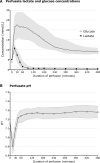Predicting Early Allograft Function After Normothermic Machine Perfusion
- PMID: 36044364
- PMCID: PMC9698137
- DOI: 10.1097/TP.0000000000004263
Predicting Early Allograft Function After Normothermic Machine Perfusion
Abstract
Background: Normothermic ex situ liver perfusion is increasingly used to assess donor livers, but there remains a paucity of evidence regarding criteria upon which to base a viability assessment or criteria predicting early allograft function.
Methods: Perfusate variables from livers undergoing normothermic ex situ liver perfusion were analyzed to see which best predicted the Model for Early Allograft Function score.
Results: One hundred fifty-four of 203 perfused livers were transplanted following our previously defined criteria. These comprised 84/123 donation after circulatory death livers and 70/80 donation after brain death livers. Multivariable analysis suggested that 2-h alanine transaminase, 2-h lactate, 11 to 29 mmol supplementary bicarbonate in the first 4 h, and peak bile pH were associated with early allograft function as defined by the Model for Early Allograft Function score. Nonanastomotic biliary strictures occurred in 11% of transplants, predominantly affected first- and second-order ducts, despite selection based on bile glucose and pH.
Conclusions: This work confirms the importance of perfusate alanine transaminase and lactate at 2-h, as well as the amount of supplementary bicarbonate required to keep the perfusate pH > 7.2, in the assessment of livers undergoing perfusion. It cautions against the use of lactate as a sole indicator of viability and also suggests a role for cholangiocyte function markers in predicting early allograft function.
Copyright © 2022 The Author(s). Published by Wolters Kluwer Health, Inc.
Conflict of interest statement
C.J.E.W. participated in advisory boards with Nefro Health and Jazz Pharmaceuticals and has received speaker fees from OrganOx. A.J.B. is coholder of a patent on the circuit used in the OrganOx metra. C.D.L.C. has received income from OrganOx Ltd for teaching and training and for carrying out normothermic preservations after normal working hours. The other authors declare no conflicts of interest.
Figures


Comment in
-
Machine Perfusion as "Comfort Zone": What Are Key Challenges of Liver Viability Assessment Today?Transplantation. 2022 Dec 1;106(12):2295-2298. doi: 10.1097/TP.0000000000004264. Epub 2022 Aug 29. Transplantation. 2022. PMID: 36044358 No abstract available.
References
-
- Watson CJE, Hunt F, Messer S, et al. . In situ normothermic perfusion of livers in controlled circulatory death donation may prevent ischemic cholangiopathy and improve graft survival. Am J Transplant. 2019;19:1745–1758. - PubMed
-
- Hessheimer AJ, Coll E, Torres F, et al. . Normothermic regional perfusion vs. super-rapid recovery in controlled donation after circulatory death liver transplantation. J Hepatol. 2019;70:658–665. - PubMed
-
- Nasralla D, Coussios CC, Mergental H, et al. ; Consortium for Organ Preservation in Europe. A randomized trial of normothermic preservation in liver transplantation. Nature. 2018;557:50–56. - PubMed
-
- van Rijn R, Schurink IJ, de Vries Y, et al. ; DHOPE-DCD Trial Investigators. Hypothermic machine perfusion in liver transplantation—a randomized trial. N Engl J Med. 2021;384:1391–1401. - PubMed
-
- Ceresa CDL, Nasralla D, Watson CJE, et al. . Transient cold storage prior to normothermic liver perfusion may facilitate adoption of a novel technology. Liver Transpl. 2019;25:1503–1513. - PubMed
Publication types
MeSH terms
Substances
Grants and funding
LinkOut - more resources
Full Text Sources
Medical

